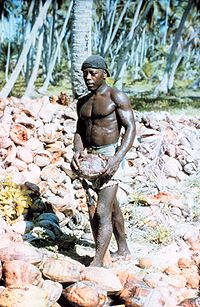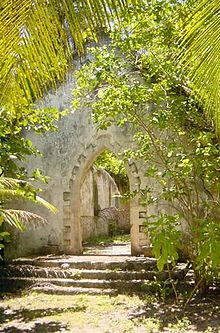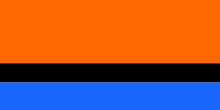- Chagossians
-
Chagossians/Chagos Islanders
Îlois
A Chagossian and his final coconut harvest, photographed at the time of the first United States encampment (1971). Regions with significant populations 3,000
in Mauritius and the United KingdomLanguages Chagossian Creole · Mauritian Creole · Seychellois Creole · English
Religion The Chagossians (also Îlois or Chagos Islanders) are an ethnic group who were the indigenous inhabitants of the Chagos Islands, British Indian Ocean Territory. The Chagossians resided in the islands of Diego Garcia, Peros Banhos, and the Salomon island chain, and had settled in other parts of the Chagos Archipelago, like Egmont Islands and Eagle Islands. Most of the Chagossians now live in Mauritius and the United Kingdom after being deported from their homeland by the British government in the late 1960s and early 1970s. This mass deportation was carried out so that Diego Garcia, the island where most Chagossians lived, could serve as the location for a military base shared between the UK and the United States. Today, there are no Chagossians that live on the island of Diego Garcia, as it is now the site of the military base Camp Justice.
The Chagossian people's ancestry is mostly of African heritage, particularly coming from Madagascar, Mozambique and other African nations including Mauritius. There is also a significant proportion of Indian ancestry. The French brought some to the Chagos islands as slaves from Mauritius in 1786. Others arrived as fishermen, farmers, and coconut plantation workers during the 19th century.
The Chagossians speak Chagossian Creole, a mix of Indigenous language and French-based creole language and part of the Bourbonnais Creole family. Chagossian Creole is still spoken by some of their descendants in Mauritius and the Seychelles. Chagossian people living in the UK speak English.
The Archipelago later passed to the control of the United Kingdom and came to form part of the Colony of Mauritius.
Contents
Deportation from homeland
In 1965, as part of a deal to grant Mauritian independence, the Chagos Archipelago was split off from the Colony and came to form the British Indian Ocean Territory. The territory's new constitution was set out in a statutory instrument imposed unilaterally without any referendum or consultation with the Chagossians and it envisaged no democratic institutions. The constitution prohibited anyone from residing in the islands without a permit.
In the following years from 1967 and 1973, the Chagossians, then numbering some 2,000 people, were expelled by the British government, first to the island of Peros Banhos, 100 miles (160 km) away from their homeland, and then, in 1973, to Mauritius (For the relationship between the Chagos Archipelago and Mauritius, see Chagos Archipelago). Their forced (and, according to some authorities, illegal) expulsion and dispossession was for the purpose of establishing a United States air and naval base on Diego Garcia, where a small contingent of UK military personnel is stationed as well.
High Court case
In early April 2006, a group of around 100 Chagossians were permitted to visit the British Indian Ocean Territory for the first time in over 30 years in a trip. The trip was organised and financed by the British Foreign Office.[1]
On May 11, 2006, the Chagossians won their case before the High Court, which ruled that they are entitled to return to the Chagos Archipelago. It remains to be seen whether when or how the judgement might be implemented in practice.[2] The UK government launched an appeal at the Court of Appeal against the May 11 ruling in June 2006. The Foreign office has put forward an argument based on the treatment of the Japanese Canadians following the attacks on Pearl Harbor.[3]
Law Lords ruling
On October 22, 2008, the Law Lords reached a decision on the appeal made by the Secretary of State for Foreign and Commonwealth Affairs of the UK, David Miliband. They found in favour of the Government in a 3-2 verdict, ending the legal process in the UK and dashing the islanders' hopes of return. The judgement was published on the UK parliament website.[4]
Marine nature reserve and cable leak
In April 2010, the British Government established a marine nature reserve around the Chagos Islands known as the Chagos Protected Area.[5] The designation proved controversial as the decision was announced during a period when the UK Parliament was in recess.[6]
On December 1, 2010, a leaked US Embassy London diplomatic cable dating back to 2009 [7] exposed British and US calculations in creating the marine nature reserve. The cable relays exchanges between US Political Counselor Richard Mills and British Director of the Foreign and Commonwealth Office Colin Roberts, in which Roberts "asserted that establishing a marine park would, in effect, put paid to resettlement claims of the archipelago’s former residents." Richard Mills concludes:
Establishing a marine reserve might, indeed, as the FCO’s Roberts stated, be the most effective long-term way to prevent any of the Chagos Islands’ former inhabitants or their descendants from resettling in the [British Indian Ocean Territory].The cable (reference ID "09LONDON1156" [8]) was classified as confidential and "no foreigners", and leaked as part of the Cablegate cache.
See also
References
- ^ BBC News. April 10, 2006. http://news.bbc.co.uk/1/hi/in_pictures/4897046.stm. Retrieved January 2, 2010.
- ^ "Court victory for Chagos families". BBC News. May 11, 2006. http://news.bbc.co.uk/1/hi/uk/4760879.stm. Retrieved January 2, 2010.
- ^ "Colourful". http://www.blackbritain.co.uk/news/details.aspx?i=2273&c=uk&h=Foreign%20Office%20scraping%20the%20bottom%20of%20the%20barrel%20with%20Chagos%20appeal,%20says%20solicitor%20for%20exiled%20Chagossians.
- ^ "Judgments - R (On The Application of Bancoult) V Secretary of State for Foreign and Commonwealth Affairs". http://www.publications.parliament.uk/pa/ld200708/ldjudgmt/jd081022/banc-1.htm. Retrieved 2008-10-22.
- ^ http://protectchagos.org/
- ^ http://www.avaaz.org/oceans_annoncement_BBC
- ^ "leaked US diplomatic cable". http://cablegate.wikileaks.org/cable/2009/05/09LONDON1156.html. Retrieved 2010-12-01.
- ^ Full discussion and copy of WikiLeaks cables - To, Passed (2011-02-04). "HMG FLOATS PROPOSAL FOR MARINE RESERVE COVERING THE CHAGOS ARCHIPELAGO (BRITISH INDIAN OCEAN TERRITORY)". The Daily Telegraph (London: TMG). ISSN 0307-1235. OCLC 49632006. http://www.telegraph.co.uk/news/wikileaks-files/london-wikileaks/8305246/HMG-FLOATS-PROPOSAL-FOR-MARINE-RESERVE-COVERING-THE-CHAGOS-ARCHIPELAGO-BRITISH-INDIAN-OCEAN-TERRITORY.html. Retrieved 2011-04-21.
External links
- UK Chagos Support Association
- Chagos Islands Site - The oldest site in favour of the Chagos Islanders
- Let Them Return - The Chagos People's Homeland Campaign
- Diego Garcia: Paradise Cleansed by John Pilger
- Spreading democracy, by any means necessary. the US/UK and Diego Garcia
- US/UK BIOT defence agreements, 1966-1982, US Court filing
- The UK Chagos Support Association
Anguillans · Ascension Islanders · Bermudians · British Virgin Islanders · Caymanians · Chagossians (Îlois) · Channel Islanders · Cornish · English · Falkland Islanders · Gibraltarians · Hongkongers (BN(O)s) · Manx · Montserratians · Northern Irish · Orcadians · Pitcairn Islanders · Saint Helenians · Scots · Shetlanders · Tristan Islanders · Turks and Caicos Islanders · Welsh
Categories:- Ethnic groups in Africa
- Ethnic groups in South Asia
- Ethnic groups in the Indian Ocean
- Ethnic groups in Mauritius
Wikimedia Foundation. 2010.


